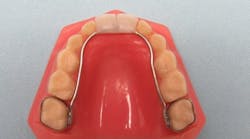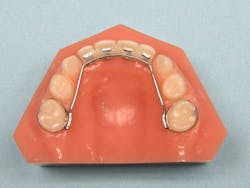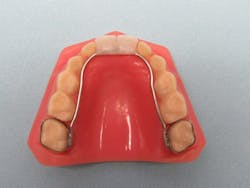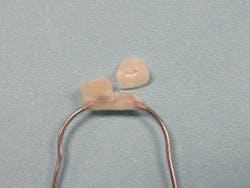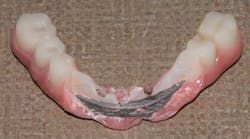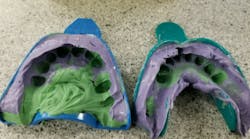How can dental professionals tell the difference between real and impostor Groper pedo partials?
metal pads for extra strength and durability.
The well-known Groper pediatric partial bridge is a space maintainer for children who have lost anterior teeth prematurely. It was first introduced in the 1980s and gained popularity among dentists due to its many benefits and durability.(1) However, recently the Groper has become a source of confusion for dentists, as some dental labs are now offering a different version of the appliance, and some dentists are fabricating them on their own. As a result, dentists and dental assistants are often surprised to find that from one lab to another, the Groper can look different, be constructed of different materials, and have different lifespans.
At the annual meeting and expo for the American Association of Pediatric Dentistry (AAPD), dozens of dentists visiting our booth (Ohlendorf Appliance Laboratory) asked why some Groper appliances don’t last as long as others. They also wanted to see what my company’s version looks like. What we learned is that many dentists are ordering a different version of the Groper that doesn’t feature its most important element—the Groper pads.
This article will address the differences in today’s Groper appliances and discuss the benefits of the appliance.
RELATED ARTICLES:Ideal dental implants—key steps to creating a perfect match
Fox Dental Lab ensures patients' mouths are 'Made in America'
to breakage because it lacks reinforcing pads.
The benefits of a Groper appliance
The Groper appliance can hold open space for a single missing tooth or as many as four missing teeth (upper and lower) that have been lost due to accident, dental caries, or illness. The Groper functions both esthetically, improving the child’s appearance, and as a preventive treatment by proactively preserving an open space to avert arch length loss and the resulting crowding. The Groper also restores function and allows maxillary growth. As a fixed rather than removable appliance, the Groper is less likely to break and doesn’t require the child’s cooperation.(2)
The Groper supports speech development in young children who have lost maxillary anterior teeth. Because the tongue uses the lingual sides of these teeth for certain phonic sounds such as “s,” “z,” and “th,” the absence of these teeth often results in improper speech.(3) While one study found that early loss of incisors had no long-term effects on speech, most dentists consider the Groper helpful in that it allows a child to communicate as he or she did before the tooth loss, which reduces frustration.(4)
Using a space maintainer such as the Groper also prevents improper tongue function. Leaving the space open, patients cannot create proper suction for swallowing and speech, so they compensate with tongue thrusting. This can lead to anterior open bites and a narrowing of the upper arch.
Another big advantage of the Groper is the social and emotional impact that a partial bridge can provide a child. Children, even those of preschool age, are aware of their appearance and can feel embarrassed or self-conscious about gaps that may last for several years until the adult teeth erupt. It’s important to choose a Groper appliance that features fully functional, realistic-looking teeth.
Acrylic resin is the preferable material over a composite because the teeth will not stain. In addition, the acrylic resin teeth are available in all shades on the Universal Shade Guide so they can be matched to a child’s natural teeth.
What’s a true Groper and how is it different?
The original or true Groper is a durable, fixed appliance designed to last until a child’s adult teeth begin to erupt. This might mean as many as two or three years, depending on the age of the child when he or she was first fitted with this custom appliance. The strength and durability of the appliance is due to its construction—each prosthetic tooth is individually attached to a metal pad that is laser welded to the palatal wire.
Some of the pseudo versions that are being labeled Groper are much less durable than a true Groper because they do not feature the pads. Instead, the appliance is simply fabricated with a wire that is adhered to the back of the prosthetic teeth. This type of appliance breaks easily, sometimes after as few as two months of use..
The Groper can be made with bands or stainless steel crowns, depending on the doctor’s preference. It can be anchored on deciduous molars or first permanent molars if these are erupted enough to band.
Conclusion
Dentists should be aware of the differences between the true Groper Pedo Partial and imitations. The most easily discerned difference is that the true Groper features an individual pad for each tooth that is laser welded to the lingual wire for additional strength. While these pads may be small, they make a big difference in terms of strength, durability, and longevity.
References
1. Jasmin JR, Groper JN. Fabrication of a more durable fixed anterior esthetic appliance. ASDC J Dent Child. 1984 Mar-Apr;51(2):124-7. http://www.ncbi.nlm.nih.gov/pubmed/6585380 Accessed August 1, 2016.
2. Waggoner WF, Kupietzky A. Anterior esthetic fixed appliances for the preschooler: considerations and a technique for placement. Pediatr Dent. 2001;23:147–50. [PubMed]
3. Fymbo L. The relation of malocclusion of the teeth to defects of speech. Arch Speech. 1936;1:204–16.
4. Gable TO, Kummer AW, Lee L, Creaghead NA, Moore LJ. Premature loss of the primary maxillary incisors: Effects on speech production. J Dent Child. 1995;62:173–79. [PubMed]
